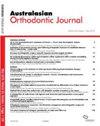Bellus3DARC-7的准确性(真实度和精密度)以及数字和手工人体测量的体内和内部可靠性分析
IF 0.9
4区 医学
Q4 DENTISTRY, ORAL SURGERY & MEDICINE
引用次数: 0
摘要
摘要背景三维面部成像正在成为一种流行的面部分析方法和人体测量的手段。3D成像有可能提供足够的诊断信息,从而及时减少对患者的辐射暴露。本研究旨在通过比较Bellus扫描获得的软组织面部标志测量值与使用游标卡尺测量值来评估Bellus3D ARC-7 (Bellus)相机的准确性。方法用标准黑色圆珠笔在白色圆形贴纸上对4例受试者的19个解剖点进行定位。使用数字卡尺测量这些点之间的距离,受试者处于休息姿势。每个科目由两名考官重复两次。随后,两名考官以微笑的姿势对每位受试者进行测量。在地标识别之后,使用Bellus相机在标准条件下拍摄图像。同样的测量结果是通过数字方式获得的,由两名审查员在每个受试者的休息和微笑姿势中重复两次。结果在数字模型上重复测量精度高,测量误差小于1.5 mm。与手动测量相比,数字测量后,检查人员内部和检查人员之间的可重复性都更高,100%的地标数字测量值落在≤1.5 mm的设定阈值偏差范围内。当比较手动和数字测量时,最大的偏差(>1.0 mm)发生在脸颊周围和面部的下三分之一区域,而耳朵和中线结构(前额和鼻梁)的测量偏差最小(≤1.0 mm)。这在休息和微笑的模特身上得到了证明。结论Bellus系统能产生准确、真实的面部图像,可在检查人员内部和之间进行重复性测量。来自Bellus3D ARC-7系统的3D面部图像可与直接人体测量相媲美,因此3D面部扫描在正畸诊断和治疗计划中的应用前景广阔。本文章由计算机程序翻译,如有差异,请以英文原文为准。
The accuracy (trueness and precision) of Bellus3DARC-7 and an in-vivo analysis of intra and inter-examiner reliability of digital and manual anthropometry
Abstract Background Three dimensional (3D) facial imaging is becoming a popular method of facial analysis and a means of anthropometry. There is potential for 3D imaging to provide enough diagnostic information to parallel lateral cephalograms, which could, in time, reduce the need for radiation exposure to patients. The present study aimed to assess the accuracy of the Bellus3D ARC-7 (Bellus) camera by comparing the measurements of soft tissue facial landmarks obtained from Bellus scans to the measurements taken using Vernier callipers. Method Nineteen anatomical points were located on four subjects using a standard black ballpoint pen on a white, circular sticker. Distances were measured between these points using digital callipers, with the subject in a resting pose. This was repeated twice by two examiners for each subject. Two examiners subsequently performed measurements of each subject in a smiling pose. Following landmark identification, images were captured under standard conditions, using the Bellus camera. The same measurements were obtained digitally, repeated twice by two examiners for each subject in both resting and smiling poses. Results There was high precision in repeated measurements on the digital models, with less than 1.5 mm deviation between measurements. Both intra-examiner and inter-examiner reproducibility were greater following the digital measurements compared to manual measurements, with 100% of the digital measurements of landmarks falling within a set threshold deviation of ≤1.5 mm. When comparing the manual and digital measurements, the greatest deviations (>1.0 mm) occurred in regions around the cheeks and lower third of the face, while the measurements for the ears and midline structures (forehead and nose bridge) deviated the least (≤1.0 mm). This was demonstrated in models at rest and smiling. Conclusions The Bellus system produced an accurate and true image of the face from which reproducible measurements can be made within and between examiners. 3D facial images from the Bellus3D ARC-7 system were comparable to direct anthropometry, therefore the use of 3D facial scanning in orthodontics for diagnosis and treatment planning appears promising.
求助全文
通过发布文献求助,成功后即可免费获取论文全文。
去求助
来源期刊

Australasian Orthodontic Journal
Dentistry-Orthodontics
CiteScore
0.80
自引率
25.00%
发文量
24
期刊介绍:
The Australasian Orthodontic Journal (AOJ) is the official scientific publication of the Australian Society of Orthodontists.
Previously titled the Australian Orthodontic Journal, the name of the publication was changed in 2017 to provide the region with additional representation because of a substantial increase in the number of submitted overseas'' manuscripts. The volume and issue numbers continue in sequence and only the ISSN numbers have been updated.
The AOJ publishes original research papers, clinical reports, book reviews, abstracts from other journals, and other material which is of interest to orthodontists and is in the interest of their continuing education. It is published twice a year in November and May.
The AOJ is indexed and abstracted by Science Citation Index Expanded (SciSearch) and Journal Citation Reports/Science Edition.
 求助内容:
求助内容: 应助结果提醒方式:
应助结果提醒方式:


